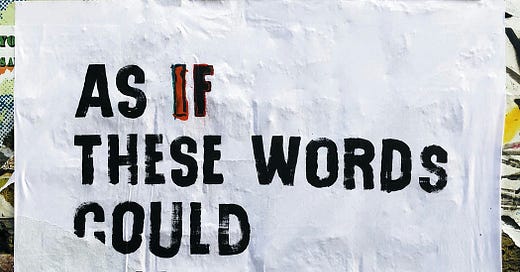If you don’t consider yourself a writer, I really hope you’ll stick around and give this article a read, because I believe anyone can write if they get out of their own way. Yes, there’s different abilities in writing just like in any endeavor, but writing is an open door in the sense that you only need a thought and some way to write it down. Okay, off my soapbox.
I want to share some of the advice I find on the internet or in books about the craft of writing because I think it’s important to challenge it. No one who knows me will faint with surprise at that statement.
Kill your darlings is one of those. It means dumping paragraphs, pages or even entire chapters because they don’t “work.” It’s painful, when you get far into a writing project, to realize something is very wrong and it’s hard to know how to fix it.
It happened recently to me on a Substack article and went something like this: I started writing. I thought of a title I loved. I kept writing and I liked what I was saying. But. But it didn’t fit the title. It became tangential to the title. So, I had a decision to make. I thought about ditching the title, but I really couldn’t because it’s exactly what I wanted to write about. Or I could throw the original stuff away and start over, even though I really liked where the article itself was going. What a conundrum and a crossroads and a calamity, or at least a complication.
A writer is constantly facing decisions through the process. There are struggles in content, voice, sentence structure, word choice and pacing, yes; but there are struggles in more esoteric things too, like what to even write about. And this is why I don’t want you to kill your darlings.
Tase them instead.
What I mean is, cut out those pesky, bad, ill-fitting parts and paste them somewhere else to save for later. I’ve come back to resuscitate entire short stories thirty years after I thought they were dead and gone, but I’ve also gone back to those cryogenically frozen bits for ideas for totally new pieces. I guess what I’m saying is that while you should tighten up your work, you should never throw anything out. You just never know when you can Frankenstein something back to life.
Adverbal Diarrhea?
Here’s another one that can cause apoplexy in some who critique writing. To say they’re not fans of adverbs is being kind. But I’m here to tell you why this part of speech can absolutely, positively be a very good thing. See what I did there?
An adverb is an adjective that describes a a verb, and I’m not sure why that is wrong in some people’s eyes. I firmly believe it’s a matter for the writer to decide, but I am on board with it being something a writer does with a purpose, as in aiming for a style or a voice or a tone. Check this out:
*Her eyes keenly swept the room before she entered.
*Her keen eyes swept the room before she entered.
One describes the action, the other her eyes. Style, voice, tone. Are her eyes, in fact, keen or was her sweeping of the room done in a keenly fashion?
Since I joined writing groups that have Adverb Police, I have been made aware of and a bit paranoid about using them. So what I do is search my work for words with ly and do a case by case analysis on whether it works there or if there is a better way to say what I wrote.
“Show, Don’t Tell”
This is a big one for fiction writers, a really big one, like the biggest. But it’s also the biggest generalization. There are times when telling works. Yes, fiction writers want to get a movie going in the readers’ heads, no doubt; but there are places in a work where giving the reader backstory or a transition or just making a statement actually makes the work stronger. Consider the very first line in one of Sinclair Lewis’ stories:
Elmer Gantry was drunk.
I mean, come on. I’m in. And just to show how you can “break” writing rules and succeed hard, here’s more of that first paragraph:
Elmer Gantry was drunk. He was eloquently drunk, lovingly and pugnaciously drunk. He leaned against the bar of the Old Home Sample Room, the most gilded and urbane saloon in Cato, Missouri, and requested the bartender to join him in “The Good Old Summer Time,” the waltz of the day.
Oh, no he didn’t. Did he use three adverbs in one sentence?! Back to Creative Writing 101, Sinclair!
I caution balance here, between showing and telling, dialog and narration. The best way to find out if you’re droning on where you could be moving action along, is to ask a beta reader to look for that. But, in the end, it’s another writer style choice.
There are so many more “rules” I could address but I think these are enough to illustrate my point. Be aware of the no-no’s and make them conscious choices. You control everything about your work, every semi-colon, capital letter, word, paragraph break. When you get a critique, give it some thought and then own your decision to change, keep or “tase” with confidence. No two writers make the same choice and no two readers will like the same things either.
The “rules” are not hard and fast, and if you read novels from even fifty years ago you might be surprised what those authors got away with before the invention of the writer’s workshop. So don’t be afraid to kick it old-school if that suits you.




